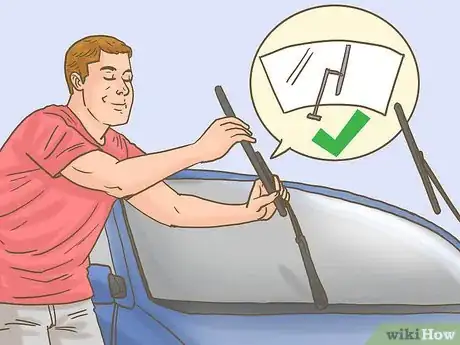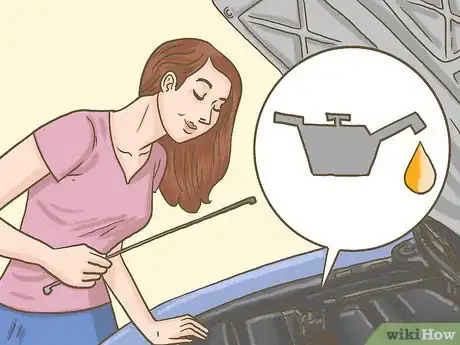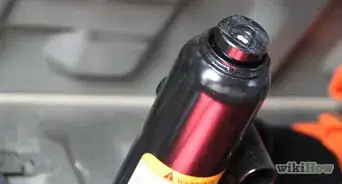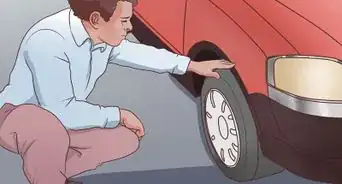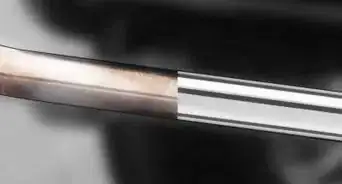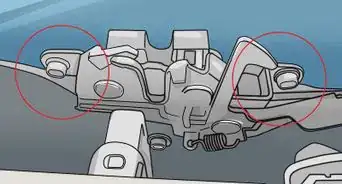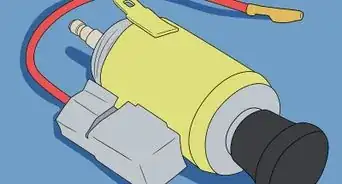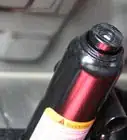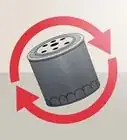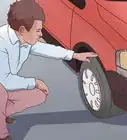This article was co-authored by Tom Eisenberg. Tom Eisenberg is the Owner and General Manager of West Coast Tires & Service in Los Angeles, California, a family-owned AAA-approved and certified auto shop. Tom has over 10 years of experience in the auto industry. Modern Tire Dealer Magazine voted his shop one of the Best 10 Operations in the Country.
There are 8 references cited in this article, which can be found at the bottom of the page.
wikiHow marks an article as reader-approved once it receives enough positive feedback. This article received 15 testimonials and 100% of readers who voted found it helpful, earning it our reader-approved status.
This article has been viewed 454,692 times.
Planning on going on a road trip soon? Before you do so, you should check your car to make sure that it is in good condition and running well. If you spend a little time preparing your vehicle for the trip beforehand, you can avoid most problems that might ruin your fun along the way.
Steps
Checklist
Inspecting Your Vehicle
-
1See if your windshield wipers need to be replaced. Like any part of a car, windshield wipers can wear out from use. They may also simply dry out and crack over time. Test your windshield wipers and make sure they can displace water effectively. If not, they’ll need to be replaced.
-
2Make sure your tires are properly inflated. Driving on underinflated tires can increase the chances that you’ll have a blowout by causing damage to the tire’s sidewall. It will also hurt your gas mileage. On tires installed by the factory, you can find the right tire pressure in the owner’s manual, but you can also find the tire’s pressure rating printed on the side of each tire.[1]
- Check your tire pressure during mild weather or in the middle of the day. Pressure changes based on the temperature. To get an accurate reading check the pressure when the outside temperature is mild instead of in extreme heat or cold.[2]
Advertisement -
3Test all of your exterior lights and the horn. Having working headlights and taillights are important for safe driving at night. Be sure your turn signals are functioning and check your license plate light as well. Turn on the headlights, parking lights, and turn signals, then check to ensure each is lighting up like it should. While you’re testing the lights, honk the horn a few times to make sure it works too.[3]
Blown-out lights can be hazardous as other drivers around you won't be able to know what you intend to do while driving, such as take a turn or put on the brakes. Also, a broken light can get you pulled over, which may leave you with an expensive ticket to pay.
-
4Inspect the tread on your tires. Balding tires can be more prone to blowouts and reduce the amount of traction your vehicle has when the roads are wet. Look for signs of damage on the sides of the tire, then use the “penny test” to see if there’s enough tread on the tire.[4]
- Place the penny upside down in the groove of the tire and see how much of Lincoln’s head you can see. If you can see further down Lincoln’s head than his forehead, the tires need to be replaced.
-
5Check the belts for condition and tightness. Look at the serpentine or accessory belts in your engine (usually located on the front or side) and make sure there is no glazing (shiny spots) or cracking. If there are, the belt will need to be replaced. Then, pinch the belt with your thumb and forefinger and move it up and down to check its tension.[5]
-
6Ensure your air filter isn't clogged. Most vehicles can go tens of thousands of miles without needing to have the air filter replaced, but it’s good to check on the condition of yours before setting out on a trip. The air filter is usually located in the air box attached to the end of an accordion looking plastic pipe often called the intake.[6]
- Most air boxes are held shut with clips. Remove them to open the box and look at the air filter.
- The filter should be free of debris and usually white. If it looks particularly dirty, replace it before closing the airbox up again.
Addressing Issues that May Arise
-
1Resolve any warning lights on your dashboard. If your check engine light is lit up on your dashboard you can use an OBDII scanner to find out what error code has prompted it. Once you know what’s wrong, you can make a plan to fix it.[7]
- Plug the scanner into the open plastic connector port beneath the dashboard on the driver’s side.
- If the scanner doesn’t provide an English description with the error code, you can find the corresponding description in a vehicle-specific repair manual or often on the manufacturer’s website.
-
2Check the oil and add more or change it, if necessary. Start by checking the oil by removing the dipstick, wiping it off with a cloth, reinserting it and removing it again. Look at the level the oil reached on the stick compared to the bottom notch (low limit) and top notch (high limit). If it’s low, you will need to either add some or change the oil.[8]
- Oil that’s in good condition will be translucent and slightly yellow or even greenish in color.
- To change the oil, slide a container under the oil pan that can capture the draining oil, then unscrew the drain plug (bolt at the bottom of the oil pan). Once the oil has drained completely, replace the plug and remove the oil filter. Install a new oil filter and then add the correct type and amount of oil for your vehicle, based on the information in your owner's manual.
-
3Top off any other fluids that may need it. Most vehicles rely on a number of different fluids and lubricants to run, ranging from coolant to stop the engine from overheating to windshield washer fluid to help wash the bugs away. Use your vehicle’s owner’s manual to tell you where the reservoir is for the windshield washer fluid and brake fluid, the add some if the level is below the lower mark on each reservoir, indicating its low-fill point.[9]
- Automatic transmission fluid is one of the most important ones to check before a long road trip. Use your vehicle’s owner’s manual to tell you where to find the dipstick, then check it like you would engine oil.
- Make sure your radiator is topped off as well by comparing its fill line to the lower limit line visible on the reservoir.
- Coolant will prevent your engine from heating up too much when you drive for long periods of time, so make sure you top it off before leaving.[10]
-
4Remove any corrosion on your battery terminals. While it can be tough to spot signs that a battery may go bad, there are things you can do to ensure your battery has a strong connection to the car’s electrical system. Look for a buildup of corrosion on the battery’s terminals, and if need be clean the battery terminals with a mixture of 1 tablespoon (15 ml) of baking soda and 1 cup (250 ml) of water. Mix the two in a bowl, then use a toothbrush to scrub the combination into the terminals.[11]
-
5Replace your brake pads if necessary. If your brakes have been squealing or it’s been more than 50,000 miles (80,000 km) since the last time you changed them, you may want to replace them before setting out on a long road trip. Access the brake pads by removing the wheels, then the two bolts securing the brake calipers to the vehicle. Slide the brake caliper off of the rotor, then remove the brake pads from the caliper.[12]
Preparing to Depart
-
1Clean out the trash in your car. Going on a road trip means you’ll be spending a lot of time in your vehicle, and you’ll need space to store things ranging from luggage to snacks. Cleaning out your car will not only make the ride more comfortable, but it will also help you stay organized when you need to find things.[13]
Try to avoid packing things over your spare tire or emergency kit if you can. Setting off with a clean and organized car can give you added peace of mind.
-
2Make sure your documents are up to date. To legally drive in the United States, you’ll need to have at least a valid driver’s license and an up to date vehicle registration. Most states also require proof of insurance. Find out what the requirements are where you’ll be traveling, and make sure you meet them.[14]
- Driving without the appropriate documentation can lead to fines or even having your car impounded.
- Keep those important documents somewhere you can easily access in case you get pulled over.
-
3Assemble an emergency kit. At the very least, you should have the tools you need to change a flat tire (emergency jack, tire iron, and spare tire) but you may want to prepare for other potential emergencies as well. Other things you may want are jumper cables, road flares, extra blankets, water, food, rain gear, or a flashlight.[15]
- It’s also a good idea to carry a first aid kit.
- You may want to tailor some emergency supplies to your family or time of year. For instance, you may want to carry cat litter to help on slippery roads during the winter.
Expert Q&A
Did you know you can get expert answers for this article?
Unlock expert answers by supporting wikiHow
-
QuestionWhat should I check in my car before hitting the road for a long trip?
 Tom EisenbergTom Eisenberg is the Owner and General Manager of West Coast Tires & Service in Los Angeles, California, a family-owned AAA-approved and certified auto shop. Tom has over 10 years of experience in the auto industry. Modern Tire Dealer Magazine voted his shop one of the Best 10 Operations in the Country.
Tom EisenbergTom Eisenberg is the Owner and General Manager of West Coast Tires & Service in Los Angeles, California, a family-owned AAA-approved and certified auto shop. Tom has over 10 years of experience in the auto industry. Modern Tire Dealer Magazine voted his shop one of the Best 10 Operations in the Country.
Auto Technician Checking the tire pressure is very important. If your car is older with a lot of mileage, it's also a good idea to check the coolant, which will prevent your car from heating up too much when you drive for long periods of time. Also, if your car uses conventional oil, change it every 3,500 to 5,000 miles. If your car uses synthetic oil, change it every 7,500 to 10,000 miles instead.
Checking the tire pressure is very important. If your car is older with a lot of mileage, it's also a good idea to check the coolant, which will prevent your car from heating up too much when you drive for long periods of time. Also, if your car uses conventional oil, change it every 3,500 to 5,000 miles. If your car uses synthetic oil, change it every 7,500 to 10,000 miles instead.
References
- ↑ Tom Eisenberg. Auto Technician. Expert Interview. 26 July 2019.
- ↑ Tom Eisenberg. Auto Technician. Expert Interview. 26 July 2019.
- ↑ https://www.popularmechanics.com/cars/a26200/car-road-trip/
- ↑ https://www.cnet.com/roadshow/news/how-to-prep-your-car-for-a-road-trip/
- ↑ https://www.familyhandyman.com/automotive/car-maintenance/serpentine-belt-how-to-check-for-wear/view-all/
- ↑ https://www.dmv.org/how-to-guides/pre-trip-maintenance.php
- ↑ Tom Eisenberg. Auto Technician. Expert Interview. 26 July 2019.
- ↑ Tom Eisenberg. Auto Technician. Expert Interview. 26 July 2019.
- ↑ https://www.cnet.com/roadshow/news/how-to-prep-your-car-for-a-road-trip/
- ↑ Tom Eisenberg. Auto Technician. Expert Interview. 26 July 2019.
- ↑ https://www.cnet.com/roadshow/news/how-to-prep-your-car-for-a-road-trip/
- ↑ https://www.familyhandyman.com/automotive/car-brakes/how-to-change-front-brake-pads/view-all/
- ↑ https://www.carproof.com/resource-centre/articles/preparing-your-vehicle-for-a-road-trip
- ↑ https://www.carproof.com/resource-centre/articles/preparing-your-vehicle-for-a-road-trip
- ↑ https://www.dmv.org/how-to-guides/emergency-kit.php
About This Article
To check your car before a road trip, start by looking over the car inside and out for any noticeable issues, like burnt out headlights, or worn windshield wipers. Make sure your tires are inflated to the pressure specified in the owner's manual, and check the tread on your tires using the penny test. Open the hood and turn on the car to make sure the serpentine and accessory belts are conditioned and tense. Before you hit the road, resolve any warning lights that appear on your dashboard to avoid issues during your trip. For tips on addressing problems as they arise and getting ready to leave, read on!

